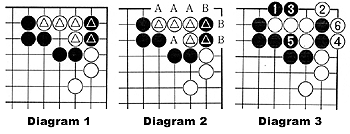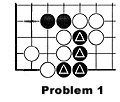Tesuji and Intuition
Although go starts with deceptively simple rules, it is a deep and complex game. The thought processes involved in planning strategy and thinking about tactics are similar to making decisions in everyday life. In the next few columns, I will explore some of these similarities.As a game progresses, sharp local clashes become commonplace. In these clashes, the players try to surround and capture each other's stones. In such situations, the more variations and the deeper the analysis, the greater the chance of success. More often than not, however, there are so many variations that the human mind is incapable of analyzing them all. Even if it were possible, it would be time-consuming. Players should use their intuition to find the key tactical move that will succeed in local clashes. These moves are called "tesuji."
When a tesuji is apparent, it can save a considerable amount of time. It is like a flash of insight and deep analysis is no longer necessary. Let me give you an example.
 The position in Diagram 1 is a capturing race. Black would like to capture the four marked white stones. If he can do this, he will save his own two marked ones. But White is ahead in this race as it has four liberties (the points marked A in Diagram 2) while Black has only three (the points marked B). The first instinct of many players would be to go directly after the white stones with a move like Black 1 in Diagram 3. But this move will not accomplish anything. White will play 2 and win the race when he captures the two black stones in the sequence up to 6.
The position in Diagram 1 is a capturing race. Black would like to capture the four marked white stones. If he can do this, he will save his own two marked ones. But White is ahead in this race as it has four liberties (the points marked A in Diagram 2) while Black has only three (the points marked B). The first instinct of many players would be to go directly after the white stones with a move like Black 1 in Diagram 3. But this move will not accomplish anything. White will play 2 and win the race when he captures the two black stones in the sequence up to 6.
Clearly, if Black is to overcome White in this race, he will have to come up with a clever move, namely a tesuji.
 The tesuji in this position is for Black to extend to the edge with 1 in Diagram 4. Once this move is made, the result of this skirmish becomes easy to analyze.
The tesuji in this position is for Black to extend to the edge with 1 in Diagram 4. Once this move is made, the result of this skirmish becomes easy to analyze.
The effect of Black 1 is to give the black stones an extra liberty, putting him a move ahead in the capturing race. If White plays on Black's liberties with 2 and 4 in Diagram 5, Black will counter with 3 and 5. White would next like to play on the point A, but, if he does, his stones will be in atari; that is, Black can capture them on the next move by playing at 6. Therefore, White must play at 6 before he can play at A. But Black plays 7 and the four white stones are in atari while the three black stones still have two liberties. If White next atari at A, Black will capture the four white stones by playing at B.
A move such as Black 1 in Diagram 4 is a tesuji that would occur instantly to a strong player. The follow-up moves leading to the successful result in Diagram 5 would also be seen in a flash.
 At right is another example with two different tesuji. In Diagram 6, the two marked black stones are isolated from their allies below. Black would like to play at A and cut off the two marked white stones, but White will play at B and the black stones will be captured.
At right is another example with two different tesuji. In Diagram 6, the two marked black stones are isolated from their allies below. Black would like to play at A and cut off the two marked white stones, but White will play at B and the black stones will be captured.
The tesuji is for Black to extend to the edge with 1 in Diagram 7. This move adds another liberty to the black group at the top, so White must defend at 2. Now comes the second tesuji.
 Black throws in a stone at 3 in Diagram 8. This sacrifice puts three white stones in atari, so White must capture it with 4. Next, Black atari with 5.
Black throws in a stone at 3 in Diagram 8. This sacrifice puts three white stones in atari, so White must capture it with 4. Next, Black atari with 5.
White gets his three stones out of atari by connecting at 6 in Diagram 9, but Black plays a final atari with 7, and this time White has no escape.
 In answer to the tesuji of Black 1, White might play 2 in Diagram 10 to reduce the liberties of the black group. Now Black cannot play A because White will atari at B, then capture the black stones. But Black can still capture some stones at the top. He atari with 3, White connects with 4, and Black atari again with 5. After White captures a stone with 6, Black atari for the last time with 7 in Diagram 11. There is now no way for White to escape capture.
In answer to the tesuji of Black 1, White might play 2 in Diagram 10 to reduce the liberties of the black group. Now Black cannot play A because White will atari at B, then capture the black stones. But Black can still capture some stones at the top. He atari with 3, White connects with 4, and Black atari again with 5. After White captures a stone with 6, Black atari for the last time with 7 in Diagram 11. There is now no way for White to escape capture.
 The way for White to defend his stones at the top after Black 1 is to connect with 2 in Diagram 12. But Black can now cut at 3. A capturing race now appears. If White 4, Black 5 atari two white stones. If White 6, Black captures two stones with 7.
The way for White to defend his stones at the top after Black 1 is to connect with 2 in Diagram 12. But Black can now cut at 3. A capturing race now appears. If White 4, Black 5 atari two white stones. If White 6, Black captures two stones with 7.
Skill in finding tesuji in games is the key to becoming a strong player. The way to develop this skill is to solve hundreds of simple tesuji problems that can be found in many problem books both in English and Japanese. Once you have thoroughly drilled yourself in such problems, you can avoid time-consuming analysis and find the best move through intuition.
 The Problem 1. The four marked black stones have only two liberties. Does Black have a tesuji that will enable him to capture the white stones in the corner before White can capture the marked stones?
The Problem 1. The four marked black stones have only two liberties. Does Black have a tesuji that will enable him to capture the white stones in the corner before White can capture the marked stones?
